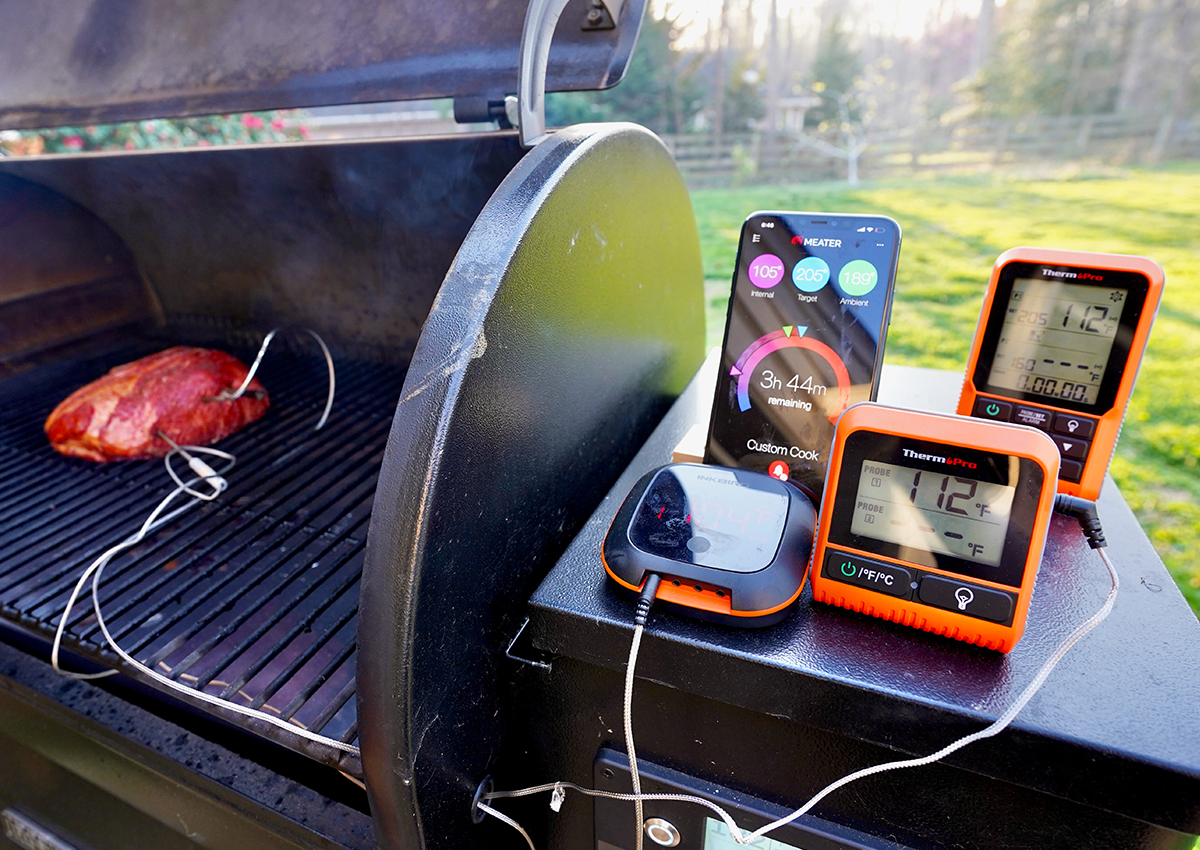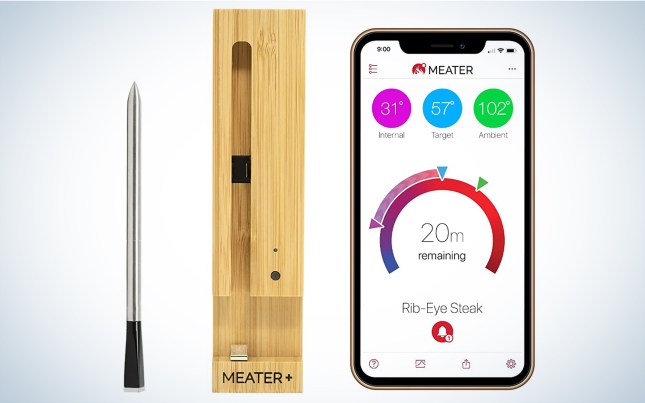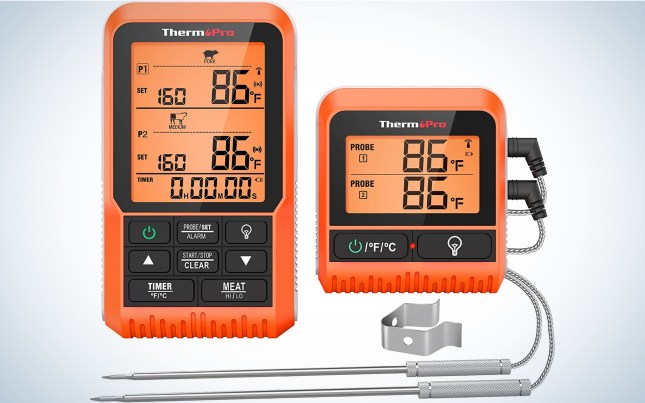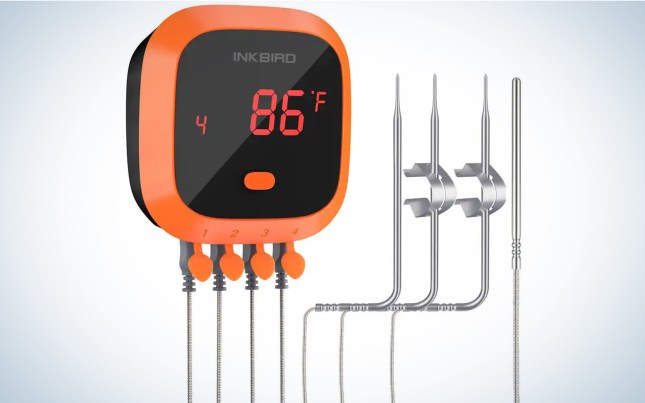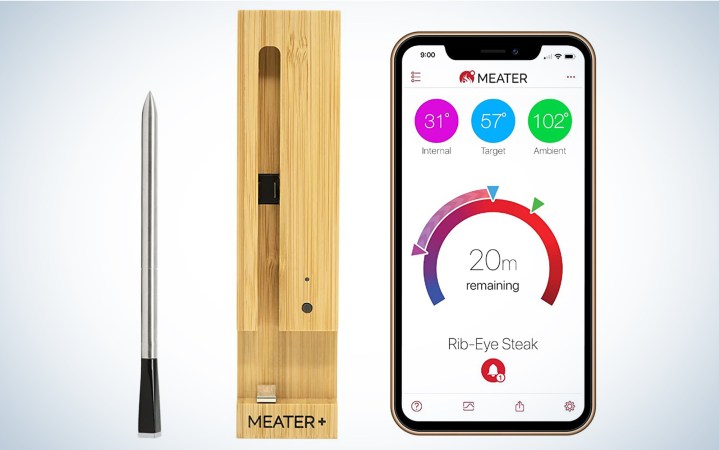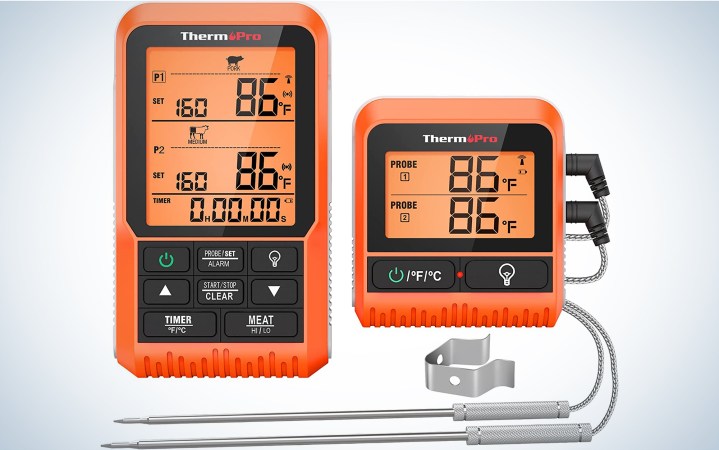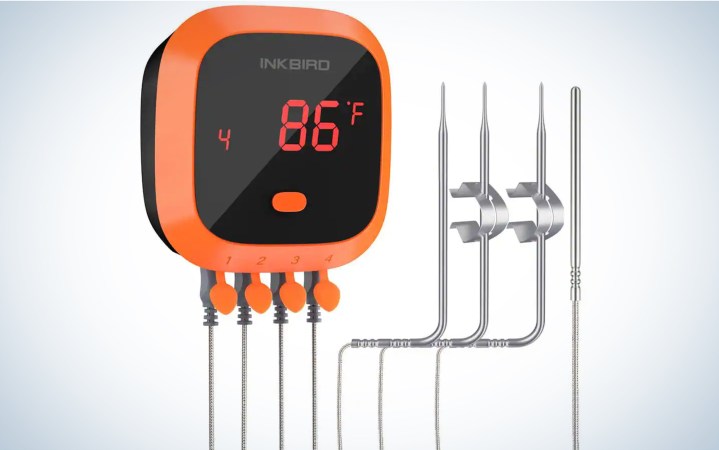We may earn revenue from the products available on this page and participate in affiliate programs. Learn More ›
I still have nightmares from the time I overcooked a beautiful porterhouse. The thick-cut, bone-in, and perfectly-marbled steak was barely edible at medium well. If only I had used a wireless meat thermometer to monitor the cook as I moved it from searing on the stove to finishing in the oven.
A wireless thermometer prevents you from opening your oven or smoker door — thus losing all your heat — to check doneness. They also help you develop your cooking instincts and feel, because you’ll have an accurate point of reference for what you see and feel when your meat is at the right temperature.
If you are done playing guessing games when it comes to preparing wild game, barbeque, and whole birds, then you need one of these best wireless meat thermometers.
- Best Overall: Meater
- Best Value: ThermoPro TP826
- Best for Multiple Probes: Inkbird
How I Tested the Best Wireless Meat Thermometers
I used each of the wireless meat thermometers to monitor a six-hour pork butt smoke. I tested the connectivity range, ease of use, and temperature accuracy during that time. To test their accuracy, I used an instant read thermometer throughout the cook to compare the temperature readings. All the wireless thermometers I tested worked well, but each has nuances that will make them better for different use cases.
Best Wireless Meat Thermometers: Reviews & Recommendations
Best Overall: Meater
Key Features
- Bluetooth
- Controlled and monitored via app
- Rechargeable battery
- 165 feet wireless range
- 24-hour battery life
- Max Internal Temp: 212 degrees
- Max Ambient Temp: 527 degrees
- Provides internal and ambient temperatures
Pros
- No wires
- Easy to setup and use
- Accurate readings
Cons
- Must insert the probe to a specific depth
The Meater has zero wires which makes it really handy to use in a smoker, grill, or oven. You insert the temperature probe up to the etched line and then monitor the temperature through the Meater app. When you take it out of the package, you’ll have to charge the battery for two hours and then pair your probe to the app. The app has easy-to-follow, guided instructions.

One thing I really like about the Meater is that it provides ambient and internal temperatures. So you can monitor the temperature of your grill, smoker, or oven and the temperature of your meat. The ambient temp reading was beneficial during my test because my pellet smoker ran out of pellets, and the falling ambient temperature alerted me to that issue. During my 6-hour cook, the temperature reading matched the other probes, and I never lost connectivity when I went inside the house or walked around the yard.

The app has a lot of functionality without being over complicated. You can set a custom temperature alert or select one of the pre-programmed ones. If you’re into nerding out about barbeque, a cool graph displays the ambient and internal temperature.
The main con is that you have to insert the probe to a specific depth (2 ⅝ inches), and it’s just one probe for $70. But despite those limitations, it’s a true wire-free thermometer that works exceptionally well.
Read Next: The Best Pellet Smokers of 2023
Best Value: ThermoPro TP826
Key Features
- Two or four probe options
- Temperature Range: 14 to 572 degrees
- Uses four AAA batteries (included)
- Eight pre-programed temperature presets and custom temp options
- 500-foot range
Pros
- No app required
- Very easy to use
- Connection range is three times app-based thermometers
Cons
- No cool charts that you get from app-based thermometers
I really like the ThermoPro for one big reason, it doesn’t require you to download an app. It consists of a base unit, which you plug the probes into, and a receiver that allows you to monitor your cook from up to 500 feet away. You just carry around the receiver to check out your internal temperature throughout the cook. The receiver has a timer and temperature alarm probe.
During my test, the performance was excellent, with no hiccups or anomalous readings. The thermometer was easy to use and accurate. I still had connection while I was in the house and when I walked 60 yards from my smoker. So it allows you to cut the grass, watch TV, or hang out with your family while you keep an eye on dinner.
The ThermoPro TP826 is ideal for minimalists who don’t want another app and just need an affordable wireless thermometer that gives accurate internal temp readings. It’s also one of the best wireless meat thermometers for staying connected over 100 yards away.
Read Next: How to Cook Venison: The Best Ways to Prepare Every Cut
Best for Multiple Probes: Inkbird
Key Features
- Temperature Range: 32 to 482 degrees
- One smart meat thermometer, three meat probes, and one ambient probe
- 150-foot range
- Rechargeable battery
- Uses BBQ Go app
Pros
- Easy setup
- Plenty of probes
- Magnetic base
Cons
- Can’t use above 480 degrees
The Inkbird is a great compromise between the simplicity of the ThermoPro and the advanced features of the Meater. The base is magnetic and displays temp info from the probes. It also connects to the BBQ Go app where you can view graphs, set custom temp alarms, set timers, and see the temperature of all four probes.

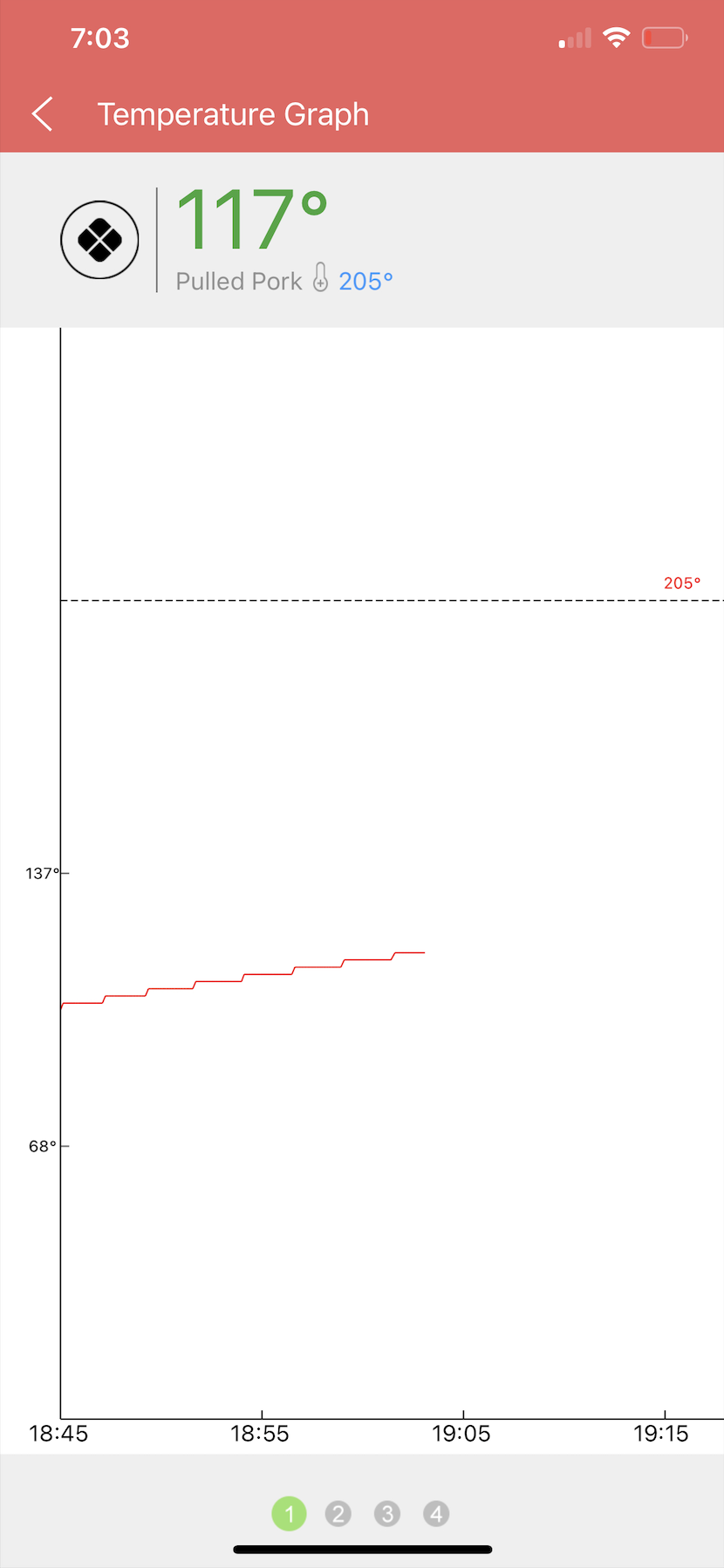
The connection range is the shortest of the thermometers I tested at 150 feet. I had issues staying connected around 120 feet, so I wouldn’t recommend it for folks that have their smoker far from their house.
How to Choose the Best Wireless Meat Thermometer
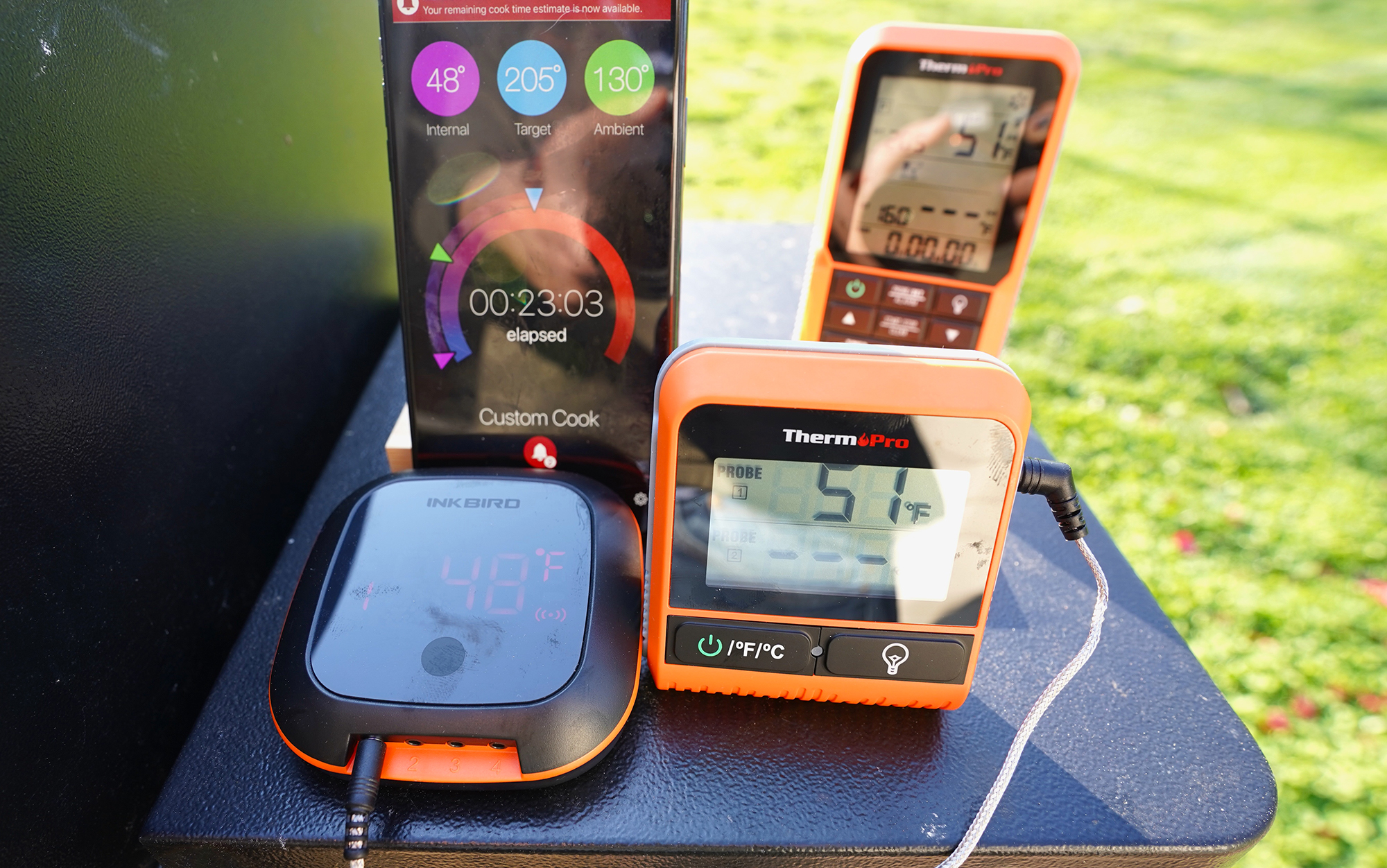
Bluetooth, WiFi, or App Free
Wireless meat thermometers connect to a receiver or an app for remote monitoring. For ease of use, reliability, and range, it’s hard to beat an app-free thermometer like the ThermoPro TP826. Bluetooth connection offers good battery life, and the thermometers cost less. WiFi connection extends the range of Bluetooth but requires a larger base and usually costs moore than Bluetooth options.
Wireless vs. Wire Free
Most thermometers are wire “less,” so they still use a wire connecting the probe to the base. But they can be monitored through an app or untethered receiver. The Meater is an exception and uses no wires, which aids in its ease of use because you don’t have to thread a wire through a vent, port, or oven door.
Read Next: What Temperature Should You Cook Venison?
Why You Need a Wireless Thermometer
Barbeque is an art, but those of us who don’t spend hours over a pit can use a little help getting large, expensive cuts just right. Even everyday cooking of steaks, whole chickens, and venison roasts are made much easier with the help of one of the best wireless meat thermometers. After using an accurate thermometer for a while, you’ll be able to use more feel and less tech in your cooking.
FAQs
Digital thermometers are usually faster and more accurate than non-digital options.
An instant-read thermometer is excellent for checking internal temperatures. A wireless meat thermometer is best for monitoring internal temperatures over a long period of time.
Wireless meat thermometers are worth buying if you are cooking large cuts over long periods of time.
Why Trust Outdoor Life?
Since 1898, OL has been a leading authority in testing and reviewing hunting gear, fishing tackle, guns and shooting equipment, and much more. We have more than a century-long history of evaluating products, and we’re now bringing that expertise to online reviews. Our editors are experienced outdoorsmen and women, and most importantly, we’re trained journalists. We prioritize field testing and objective data when reviewing products. We conduct interviews with gear manufacturers and engineers as well as outdoor experts so that our readers have an understanding of how and why a product works—or doesn’t.
Advertising does not influence our gear reviews and it never will. While we always focus our coverage on standout products—because we want our readers to be aware of the latest and greatest gear—we also cover the flaws and quirks of any given product.
Final Thoughts
Overcooked venison is dry and chewy, undercooked brisket is tough, and undercooked bear meat is dangerous to eat. When you don’t want to chance a bad meal or case of trichinosis, I recommend using of the best wireless meat thermometers. They’re an easy way to hit the proper doneness no matter what you’re cooking.
- Best Overall: Meater
- Best Value: ThermoPro TP826
- Best for Multiple Probes: Inkbird
